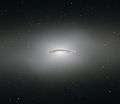NGC 4526
| NGC 4526 | |
|---|---|
|
Supernova SN 1994D (lower left) in the outskirts of NGC 4526 | |
| Observation data (J2000 epoch) | |
| Constellation | Virgo |
| Right ascension | 12h 34m 03.029s[1] |
| Declination | +07° 41′ 56.90″[1] |
| Redshift | 0.001494±0.000027 |
| Helio radial velocity | 448±8 km/s[2] |
| Distance | 55±5 Mly (16.9±1.6 Mpc)[3] |
| Type | SAB(s)0°[4] |
| Apparent dimensions (V) | 7′.2 × 2′.4[2] |
| Apparent magnitude (V) | 10.7[2] |
| Other designations | |
| NGC 4560,[2] UGC 7718,[2] PGC 41772[2] | |
NGC 4526 is a lenticular galaxy in the Virgo constellation that is seen nearly edge-on. The morphological classification is SAB(s)0°,[4] which indicates a lenticular structure with a weak bar across the center and pure spiral arms without a ring.[5] It belongs to the Virgo cluster and is one of the brightest known lenticular galaxies.[4] The inner nucleus of this galaxy displays a rise in stellar orbital motion that indicates the presence of a central dark mass. The best fit model for the motion of molecular gas in the core region suggests there is a supermassive black hole with about 4.5+4.2
−3.0×108 (450 million) times the mass of the Sun.[6] This is the first object to have its black-hole mass estimated by measuring the rotation of gas molecules around its centre with an Astronomical interferometer (in this case the Combined Array for Research in Millimeter-wave Astronomy).
Supernova SN 1969E was discovered in this galaxy in 1969, reaching a peak magnitude of 16.[7] In 1994, a Type 1a supernova was discovered about two weeks before reaching peak brightness. Designated SN 1994D, it was caused by the explosion of a white dwarf star composed of carbon and oxygen.[8]
Gallery
-

NGC 4526 spins at more than 250 kilometres per second.[1]
- ^ "The whirling disc of NGC 4526". www.spacetelescope.org. ESA/Hubble. Retrieved 20 October 2014.
See also
References
- 1 2 Skrutskie, M. F.; et al. (February 2006), "The Two Micron All Sky Survey (2MASS)", Astrophysical Journal 131 (2): 1163–1183, Bibcode:2006AJ....131.1163S, doi:10.1086/498708.
- 1 2 3 4 5 6 "NASA/IPAC Extragalactic Database", Results for NGC 4526, retrieved 2006-10-18.
- ↑ Tonry, J. L.; et al. (2001), "The SBF Survey of Galaxy Distances. IV. SBF Magnitudes, Colors, and Distances", Astrophysical Journal 546 (2): 681–693, arXiv:astro-ph/0011223, Bibcode:2001ApJ...546..681T, doi:10.1086/318301.
- 1 2 3 Burstein, D. (November 1979), "Structure and origin of S0 galaxies. I - Surface photometry of S0 galaxies", Astrophysical Journal Supplement Series 41: 435–450, Bibcode:1979ApJS...41..435B, doi:10.1086/190625.
- ↑ Buta, Ronald J.; et al. (2007), Atlas of Galaxies, Cambridge University Press, pp. 13–17, ISBN 0521820480.
- ↑ Davis, Timothy A.; et al. (February 2013), "A black-hole mass measurement from molecular gas kinematics in NGC4526", Nature 494 (7437): 328–330, arXiv:1301.7184, Bibcode:2013Natur.494..328D, doi:10.1038/nature11819.
- ↑ Kowal, C. T.; Sargent, W. L. W. (November 1971), "Supernovae discovered since 1885", Astronomical Journal 41: 756–764, Bibcode:1971AJ.....76..756K, doi:10.1086/111193.
- ↑ Lentz, Eric J.; et al. (August 2001), "Non-LTE Synthetic Spectral Fits to the Type Ia Supernova 1994D in NGC 4526", The Astrophysical Journal 557 (1): 756–764, arXiv:astro-ph/0104225, Bibcode:2001ApJ...557..266L, doi:10.1086/322239.
External links
| ||||||||||
